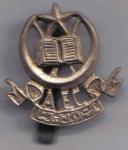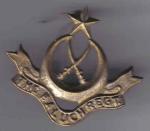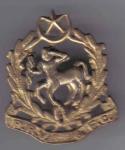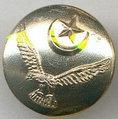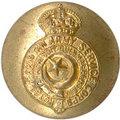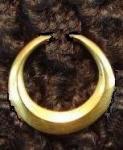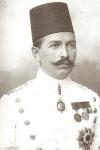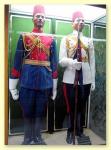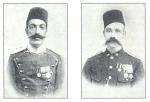
jj08
For Deletion-
Posts
74 -
Joined
-
Last visited
Content Type
Profiles
Forums
Blogs
Gallery
Events
Store
Everything posted by jj08
-
02-268 SIX-PLACE RIBBON BAR - WAR MINISTRY CERTIFICATION. The War Ministry (Kriegsministerium) was extensively involved in all aspects of headdress and uniform items. Within the War Ministry was a department that approved and certified all changes to headdresses and uniforms. The department prepared an example of the proposed change, which was then attached to a card describing the item and the date of the change. We have offered various examples of such items in the past. Today we are offering you something quite different. It is a six-place ribbon bar. The ribbon bar measures 3 1/4" x 3/4," and from left to right it has the following ribbons: * The 1914 Iron Cross 2nd Class. * The Red Eagle Order. * The Crown Order. * The Twenty or Twenty-Five-Year Long-Service Decoration. * The Southwest African Combatants or Non Combatants Decoration. * The Kaiser Wilhelm I Centennial Medal. The ribbon bar and change were devised to show the official size and method for preparing ribbon bars during the World War. The card?s front (the card measures 4 1/4" x 2 3/4") advises that the change was authorized on 21 September 1915. It has the catalog number and the item?s name (Ordensschalle), the department?s name, and the authorizing officer?s name. The card?s reverse features a red wax seal bearing the Prussian Eagle and the Ministry?s name. Imagine having Imperial Germany?s FIRST official template for constructing WW I (1915-1918) ribbon bars in your personal collection! $850.0 www.derrittmeister.com
-
Odd assortment, I keep a record of these because people often try to sell Pakistani army insignia as WW1 Turkish!
-
All I can add, is that prior to 1908, the Ottoman Turkish troops do have a white cotton or linen uniform of this type worn in the 5th, 6th, 7th armies in summer. The Turban was worn by the zouave and by troops from Africa (libya), which also incorporated the badge from the Order or Orta (see attached). The "French" brade on the cuff is typical of the Gendermerie. The large plain square brass buckle is the same pattern (and manufacture) as the French equipment buckle.
-
Mark, Good analysis. That is something I had not considered, which was the facings could be white - I hope not - because then we are "all at sea" as to what this uniform actually is. You are correct - the photo is from the Cairo Military Museum. I suspect/ my research indicates that the Khedivial staff were likely to wear standard Turkish uniforms, and the photo of KHEDIVE Abbas Hilmi II of Egypt (attached) very much demonstrates this. However, note his shoulder boards - here is wearing a M1879 Ottoman Turkish summer Marshal?s uniform (three large Silver shoulder board stars) including British Marshal?s crossed battons. I have found an interesting set of references to the Egyptian army uniform, in Sidney Low, "Egypt in Transition" . The London Daily Chronicle. Reprinted in New York Times (2nd May, 1915). "The British Officers in the native regiments were merely ?lent? to the Egyptian War Office for the service of the Khedival Army, which was technically a branch of the Turkish forces, with Turkish badges and Turkish insignia?. Paintings in the National Army Museum (london) from the 1890s clearly show Egypian soldiers in British summer uniforms but with Turkish insignia, and this does explain the number of british made Turkish buttons that seem to be about. As to the Khedivial guard regiments of horse and foot, these clerely wore copies of the Sultan personnel Infantry and Cavalry, which were the again similar in pattern to the 1st Lancers, and the Ertugrul Cavalry regt.
-
Mark Totally correct. The Commadant rank still exists in the modern turkish army, and plays exactly the role you discribe. Pinning down Egyptian uniforms is a bit more problematic. There seems to have been quite a bit of mix of British, Turkish (which the Khedivial army was actually still a part), as well as some local Egyptian characteristics. I think we are looking at a mixed uniform.
-
France Just a pocket watch: Capitaine Marcel Verzieux 3e Regt de Génie
jj08 replied to Michael Johnson's topic in France
Michael, this is an interesting adaptation. Fitted to the FRENCH ARS 1917 is a GERMAN M18 additional clip-on Arsine Gas filter. It is not a surprise that these parts can fit, as the F ARS 17 was largely made to similar specifications to standard GERMAN gasmasks of the period. Here is a photo of the M18 additional clip-on Arsine Gas filter: -
Shoulder boards
jj08 replied to ccj's topic in Germany: Imperial: Uniforms, Headwear, Insignia & Personal Equipment
-
Shoulder boards
jj08 replied to ccj's topic in Germany: Imperial: Uniforms, Headwear, Insignia & Personal Equipment

